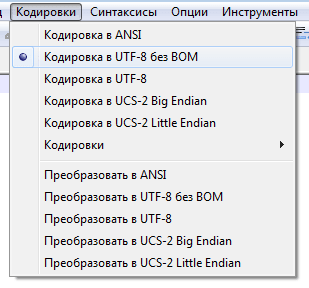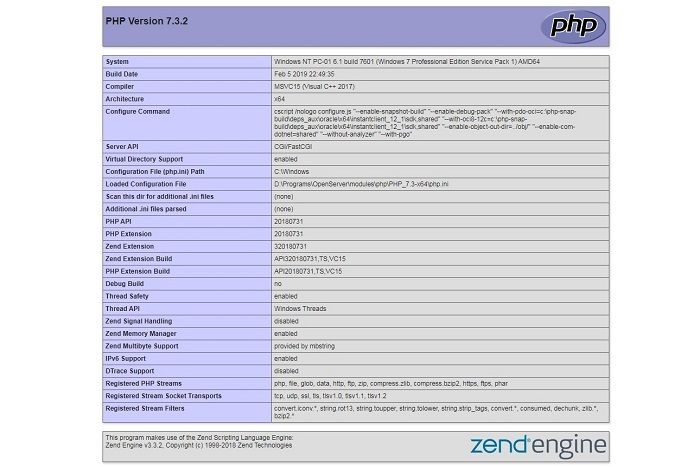php html код в одну строку
htmlspecialchars_decode
(PHP 5 >= 5.1.0, PHP 7, PHP 8)
htmlspecialchars_decode — Преобразует специальные HTML-сущности обратно в соответствующие символы
Описание
Список параметров
Строка, которую надо преобразовать.
Возвращаемые значения
Возвращает преобразованную строку.
Список изменений
Примеры
Пример #1 Пример использования функции htmlspecialchars_decode()
Результат выполнения данного примера:
Смотрите также
User Contributed Notes 8 notes
The example for «htmlspecialchars_decode()» below sadly does not work for all PHP4 versions.
Quote from the PHP manual:
«get_html_translation_table() will return the translation table that is used internally for htmlspecialchars() and htmlentities().»
But it does NOT! At least not for PHP version 4.4.2.
This was already reported in a bug report (http://bugs.php.net/bug.php?id=25927), but it was marked as BOGUS.
This comment now is not to report this bug again (though I really believe it is one), but to complete the example and warn people of this pitfall.
To make sure your htmlspecialchars_decode fake for PHP4 works, you should do something like this:
This should be the best way to do it.
(Reposted because the other one seems a bit slower and because those who used the code under called it htmlspecialchars_decode_php4)
that works also with ä and » and so on.
get_html_translation_table(HTML_ENTITIES) => offers more characters than HTML_SPECIALCHARS
function htmlspecialchars_decode_PHP4($uSTR)
<
return strtr($uSTR, array_flip(get_html_translation_table(HTML_ENTITIES, ENT_QUOTES)));
>
Well, consider someone sending ‘&’ to your PHP script:
There is, unfortunately, no reliable way to determine whether HTML is escaped or not that does not come with this caveat that I know of. Rather than try and catch the case ‘I’ve already encoded this’, you are better off avoiding double-escaping by simply escaping the HTML as close to the actual output as you can muster, e.g. in the view in an MVC development structure.
If you use `htmlspecialchars()` to change things like the ampersand (&) into it’s HTML equivalent (&), you might run into a situation where you mistakenly pass the same string to the function twice, resulting in things appearing on your website like, as I call it, the ampersanded amp; «&». Clearly nobody want’s «&» on his or her web page where there is supposed to be just an ampersand. Here’s a quick and easy trick to make sure this doesn’t happen:
= «This is a string that could be passed to htmlspecialchars multiple times.» ;
?>
Now, if your dealing with text that is a mixed bag (has HTML entities and non-HTML entities) you’re on your own.
[Update of previous note, having noticed I forgot to put in quote style]
PHP4 Compatible function:
// you can do it a bunch of times, it still won’t screw you!
?>
Put it in a function. Add it to the method of some abstract data class.
For PHP4 Compatibility:
htmlspecialchars
(PHP 4, PHP 5, PHP 7, PHP 8)
htmlspecialchars — Преобразует специальные символы в HTML-сущности
Описание
Список параметров
Конвертируемая строка ( string ).
Необязательный аргумент, определяющий кодировку, используемую при конвертации символов.
Если не указан, то значение по умолчанию для encoding зависит от конфигурационной опции default_charset.
Хотя этот аргумент является технически необязательным, настоятельно рекомендуется указать правильное значение для вашего кода, опция конфигурации default_charset может быть задана неверно для входных данных.
Поддерживаются следующие кодировки:
| Кодировка | Псевдонимы | Описание |
|---|---|---|
| ISO-8859-1 | ISO8859-1 | Западно-европейская Latin-1. |
| ISO-8859-5 | ISO8859-5 | Редко используемая кириллическая кодировка (Latin/Cyrillic). |
| ISO-8859-15 | ISO8859-15 | Западно-европейская Latin-9. Добавляет знак евро, французские и финские буквы к кодировке Latin-1 (ISO-8859-1). |
| UTF-8 | 8-битная Unicode, совместимая с ASCII. | |
| cp866 | ibm866, 866 | Кириллическая кодировка, применяемая в DOS. |
| cp1251 | Windows-1251, win-1251, 1251 | Кириллическая кодировка, применяемая в Windows. |
| cp1252 | Windows-1252, 1252 | Западно-европейская кодировка, применяемая в Windows. |
| KOI8-R | koi8-ru, koi8r | Русская кодировка. |
| BIG5 | 950 | Традиционный китайский, применяется в основном на Тайване. |
| GB2312 | 936 | Упрощённый китайский, стандартная национальная кодировка. |
| BIG5-HKSCS | Расширенная Big5, применяемая в Гонконге. | |
| Shift_JIS | SJIS, SJIS-win, cp932, 932 | Японская кодировка. |
| EUC-JP | EUCJP, eucJP-win | Японская кодировка. |
| MacRoman | Кодировка, используемая в Mac OS. | |
| » | Пустая строка активирует режим определения кодировки из файла скрипта (Zend multibyte), default_charset и текущей локали (смотрите nl_langinfo() и setlocale() ) в указанном порядке. Не рекомендуется к использованию. |
Замечание: Остальные кодировки не поддерживаются, вместо них будет применена кодировка по умолчанию и сгенерировано предупреждение.
Если параметр double_encode выключен, то PHP не будет преобразовывать существующие html-сущности. По умолчанию преобразуется все без ограничений.
Возвращаемые значения
Преобразованная строка ( string ).
Есть ли какие-то методы написания кода, когда надо смешать php и html в одной строке?
Допустим, есть простейший код ссылки, как показано ниже.
Например, в итогововом коде на место page.html и Страница надо поставить переменные из php. Если строка в одинарных кавычках, придется задействовать конкатенацию. Уже на 2 заменах читаемость кода значительно снижается. Если таких подстановок 5-10, то код превратится в невообразимую кашу. Есть ли какие-то проверенные подходы для решения этой проблемы, кроме двойных кавычек?
DevMan, изначально php и являлся языком для описания шаблонов
просто подход признан устаревшим, но не использовать его не возбраняется
не нужно совмещать в одном файле шаблон и логику
Как жаль что это мало кто понимает
Нагенирируют тьму логики и кода там где это не требуется, потом тратят огромные ресурсы чтобы решить проблемы, возникающие из-за такого велосипедостроения.
Как жаль что это мало кто понимает
Нагенирируют тьму логики и кода там где это не требуется
например?
логика отображения что в пыхе, что в шаблонизаторе будет одинакова. только в шаблонизаторе будет выглядеть «чище».
а хороший шаблонизатор наоборот не даст воткнуть логику приложения в шаблон, в отличие от пыха.
потом тратят огромные ресурсы чтобы решить проблемы, возникающие из-за такого велосипедостроения
а в целом, при повсеместном переходе на богатый фронт, это уже не особо роялит.
Функции для работы со строками
Для получения информации о более сложной обработке строк обратитесь к функциями Perl-совместимых регулярных выражений. Для работы с многобайтовыми кодировками посмотрите на функции по работе с многобайтовыми кодировками.
Содержание
User Contributed Notes 24 notes
I’m converting 30 year old code and needed a string TAB function:
//tab function similar to TAB used in old BASIC languages
//though some of them did not truncate if the string were
//longer than the requested position
function tab($instring=»»,$topos=0) <
if(strlen($instring)
In response to hackajar yahoo
No string-to-array function exists because it is not needed. If you reference a string with an offset like you do with an array, the character at that offset will be return. This is documented in section III.11’s «Strings» article under the «String access and modification by character» heading.
I use these little doo-dads quite a bit. I just thought I’d share them and maybe save someone a little time. No biggy. 🙂
Just a note in regards to bloopletech a few posts down:
The word «and» should not be used when converting numbers to text. «And» (at least in US English) should only be used to indicate the decimal place.
Example:
1,796,706 => one million, seven hundred ninety-six thousand, seven hundred six.
594,359.34 => five hundred ninety four thousand, three hundred fifty nine and thirty four hundredths
/*
* example
* accept only alphanum caracteres from the GET/POST parameters ‘a’
*/
/**
Utility class: static methods for cleaning & escaping untrusted (i.e.
user-supplied) strings.
Any string can (usually) be thought of as being in one of these ‘modes’:
pure = what the user actually typed / what you want to see on the page /
what is actually stored in the DB
gpc = incoming GET, POST or COOKIE data
sql = escaped for passing safely to RDBMS via SQL (also, data from DB
queries and file reads if you have magic_quotes_runtime on—which
is rare)
html = safe for html display (htmlentities applied)
Always knowing what mode your string is in—using these methods to
convert between modes—will prevent SQL injection and cross-site scripting.
This class refers to its own namespace (so it can work in PHP 4—there is no
self keyword until PHP 5). Do not change the name of the class w/o changing
all the internal references.
Example usage: a POST value that you want to query with:
$username = Str::gpc2sql($_POST[‘username’]);
*/
Example: Give me everything up to the fourth occurance of ‘/’.
to: james dot d dot baker at gmail dot com
PHP has a builtin function for doing what your function does,
//
// string strtrmvistl( string str, [int maxlen = 64],
// [bool right_justify = false],
// [string delimter = «
\n»])
//
// splits a long string into two chunks (a start and an end chunk)
// of a given maximum length and seperates them by a given delimeter.
// a second chunk can be right-justified within maxlen.
// may be used to ‘spread’ a string over two lines.
//
I really searched for a function that would do this as I’ve seen it in other languages but I couldn’t find it here. This is particularily useful when combined with substr() to take the first part of a string up to a certain point.
?>
Example: Give me everything up to the fourth occurance of ‘/’.
The functions below:
Are correct, but flawed. You’d need to use the === operator instead:
Here’s a simpler «simplest» way to toggle through a set of 1..n colors for web backgrounds:
Here’s an easier way to find nth.
I was looking for a function to find the common substring in 2 different strings. I tried both the mb_string_intersect and string_intersect functions listed here but didn’t work for me. I found the algorithm at http://en.wikibooks.org/wiki/Algorithm_implementation/Strings/Longest_common_substring#PHP so here I post you the function
A comprehensive concatenation function, that works with array and strings
function str_cat () <
$args = func_get_args () ;
Here is a truly random string generator it uses the most common string functions it will work on anywhere.
/*
Written By James Baker, May 27th 2005
sentenceCase($string);
$string: The string to convert to sentence case.
Converts a string into proper sentence case (First letter of each sentance capital, all the others smaller)
Example Usage:
echo sentenceCase(«HELLO WORLD. THIS IS A CAPITALISED SENTENCE. this isn’t.»);
Returns:
Hello world. This is a capitalised sentence. This isn’t.
*/
If you want a function to return all text in a string up to the Nth occurrence of a substring, try the below function.
(Pommef provided another sample function for this purpose below, but I believe it is incorrect.)
/*
// prints:
S: d24jkdslgjldk2424jgklsjg24jskgldjk24
1: d
2: d24jkdslgjldk
3: d24jkdslgjldk24
4: d24jkdslgjldk2424jgklsjg
5: d24jkdslgjldk2424jgklsjg24jskgldjk
6: d24jkdslgjldk2424jgklsjg24jskgldjk24
7: d24jkdslgjldk2424jgklsjg24jskgldjk24
*/
?>
Note that this function can be combined with wordwrap() to accomplish a routine but fairly difficult web design goal, namely, limiting inline HTML text to a certain number of lines. wordwrap() can break your string using
, and then you can use this function to only return text up to the N’th
.
You will still have to make a conservative guess of the max number of characters per line with wordwrap(), but you can be more precise than if you were simply truncating a multiple-line string with substr().
= ‘Lorem ipsum dolor sit amet, consectetuer adipiscing elit. Pellentesque id massa. Duis sollicitudin ipsum vel diam. Aliquam pulvinar sagittis felis. Nullam hendrerit semper elit. Donec convallis mollis risus. Cras blandit mollis turpis. Vivamus facilisis, sapien at tincidunt accumsan, arcu dolor suscipit sem, tristique convallis ante ante id diam. Curabitur mollis, lacus vel gravida accumsan, enim quam condimentum est, vitae rutrum neque magna ac enim.’ ;
Lorem ipsum dolor sit amet, consectetuer adipiscing elit. Pellentesque id massa. Duis sollicitudin
ipsum vel diam. Aliquam pulvinar sagittis felis. Nullam hendrerit semper elit. Donec convallis
mollis risus. Cras blandit mollis turpis. Vivamus facilisis, sapien at tincidunt accumsan, arcu
Lorem ipsum dolor sit amet, consectetuer adipiscing elit. Pellentesque id massa. Duis sollicitudin
ipsum vel diam. Aliquam pulvinar sagittis felis. Nullam hendrerit semper elit. Donec convallis
mollis risus. Cras blandit mollis turpis. Vivamus facilisis, sapien at tincidunt accumsan, arcu
dolor suscipit sem, tristique convallis ante ante id diam. Curabitur mollis, lacus vel gravida
I’ve prepared this simple function to obtain a string delimited between tags (not only XML tags!). Anybody needs something like this?.
Get the intersection of two strings using array_intersect
?>
For more advanced comparison you can use array_uintersect as well.
Синтаксис PHP
Как работают PHP скрипты
PHP работает точно также. Ты пишешь команды одну за другой, а PHP последовательно их исполняет.
Что такое PHP скрипт
Но есть одно важное отличие:
Скрипты запускаются только через http-запросы в браузере. Это значит, что для запуска скрипта script.php необходимо в адресной строке браузера написать site.ru/script.php
Веб-серверы чаще всего настроены так, что при заходе на главную страницу (например site.ru ) автоматически запускается файл index.php или index.html, лежащий в корне сайта.
Создай в корневой папке сайта файл с названием index.php и открой его в своём текстовом редакторе. При наличии файла index.html его нужно удалить.
Обязательно следи за кодировкой скриптов. Кодировка должна быть либо UTF-8 без BOM (если такая доступна в твоём редакторе), либо просто UTF-8.
Вывод чисел и строк в PHP
Команда echo отвечает за вывод информации на экран. После оператора указывается значение, которое нужно вывести.
Чтобы вывести текст, его нужно указать в одинарных или двойных кавычках:
Команды в PHP разделяются точкой с запятой. Для удобства чтения каждую команду принято писать с новой строки:
Результат в браузере:
Вывод HTML кода в PHP
HTML-код можно перемешивать с командами PHP:
Также HTML код можно подставить в PHPшную строку:
Результат в браузере:
Мы можем как угодно совмещать PHP код и HTML теги:
Функции в PHP
Функция phpinfo() выводит на экран информацию с текущими настройками PHP.
Некоторые функции ожидают, что им передадут какое-нибудь значение. Например, функция округления ceil() ожидает число, которое она округлит:
Функции будут подробно рассмотрены в отдельном уроке.
Необходимость закрывающего тега в PHP
Сокращённый синтаксис открывающего тега в PHP
Кроме этого, мы можем заменить тег на более короткую версию :
Использование тега вызывало множество споров в среде PHP разработчиков. Точку в этом вопросе поставили создатели языка PHP: начиная с PHP 7.4 короткий тег объявлен устаревшим, а в PHP 8 его уже не будет.
Комментарии в PHP
Однострочные комментарии в PHP пишутся после символа # или // и действуют до конца строки:
Многострочные комментарии размещаются между /* и */ :
Обратите внимание, многострочные комментарии нельзя вкладывать друг в друга:
Итого
Важно следить за кодировкой скриптов и выбирать либо UTF-8 без BOM, либо просто UTF-8.
Для вывода каких-либо значений в браузер используется команда echo, либо сокращённый синтаксис :
Функции в PHP указываются с круглыми скобками в конце:
Также в PHP можно добавлять однострочные и многострочные комментарии:






